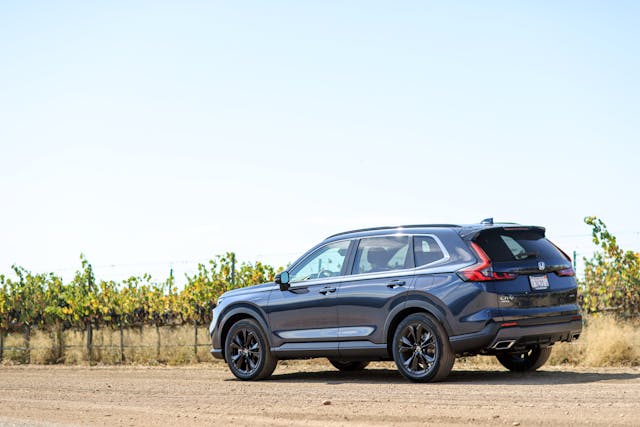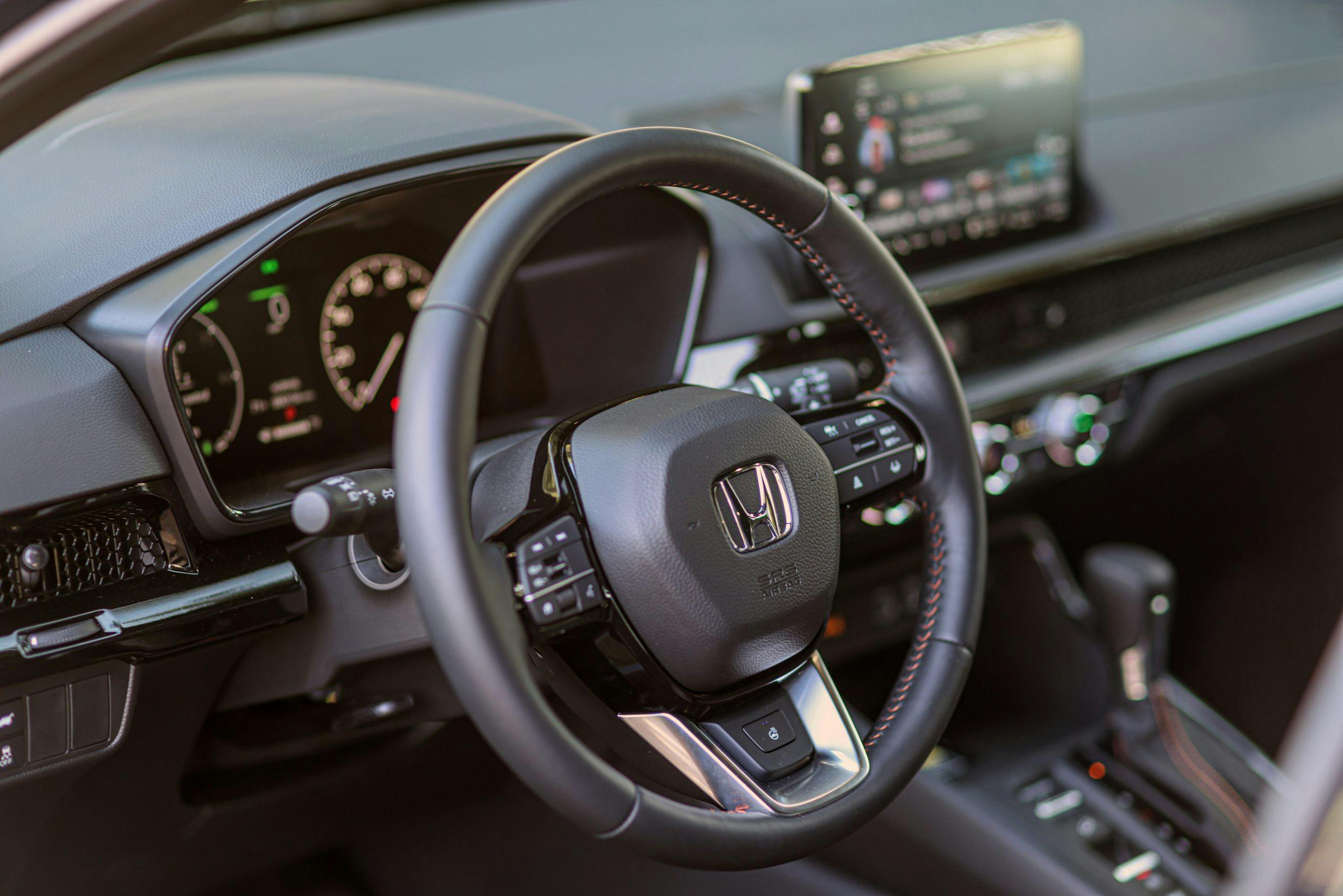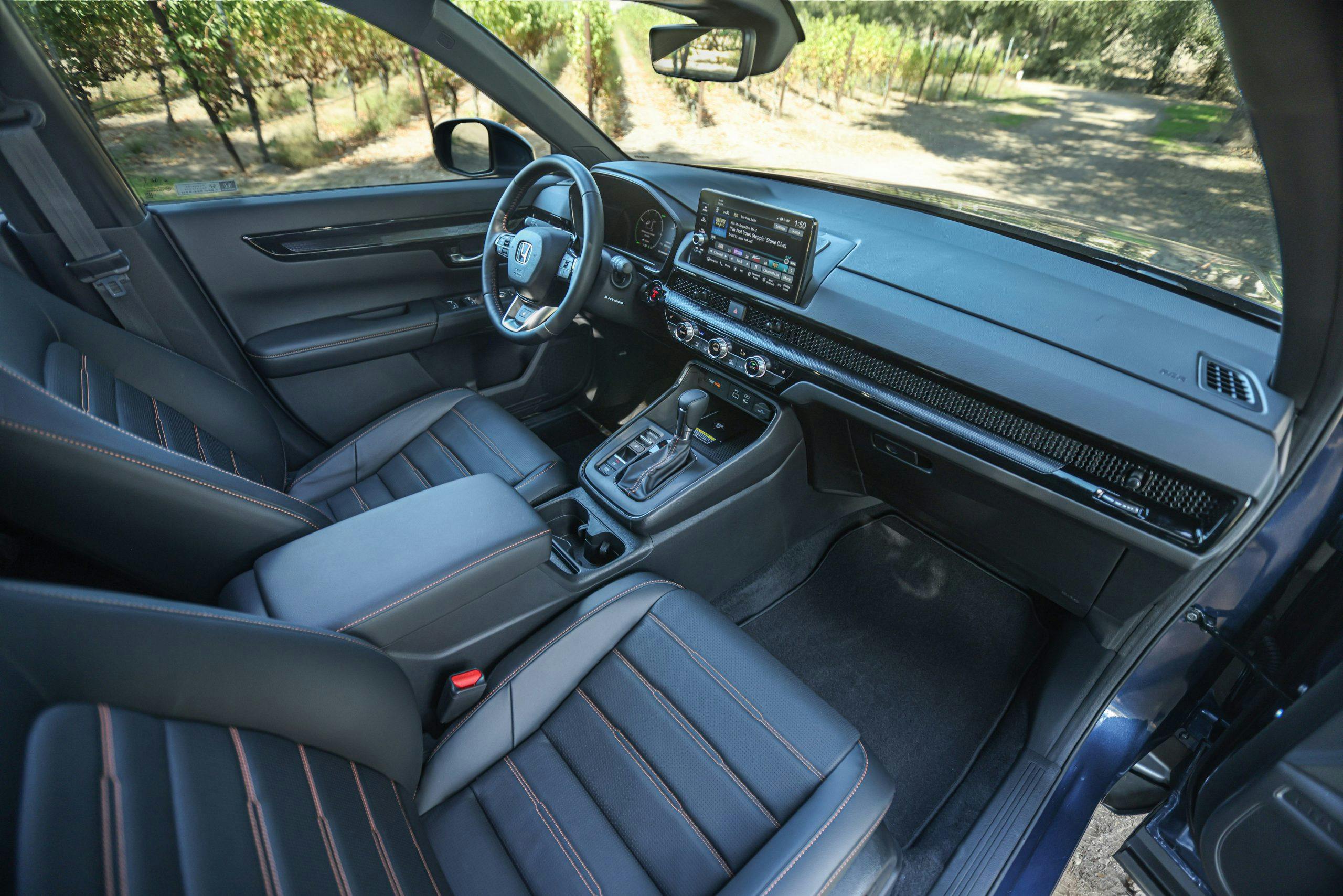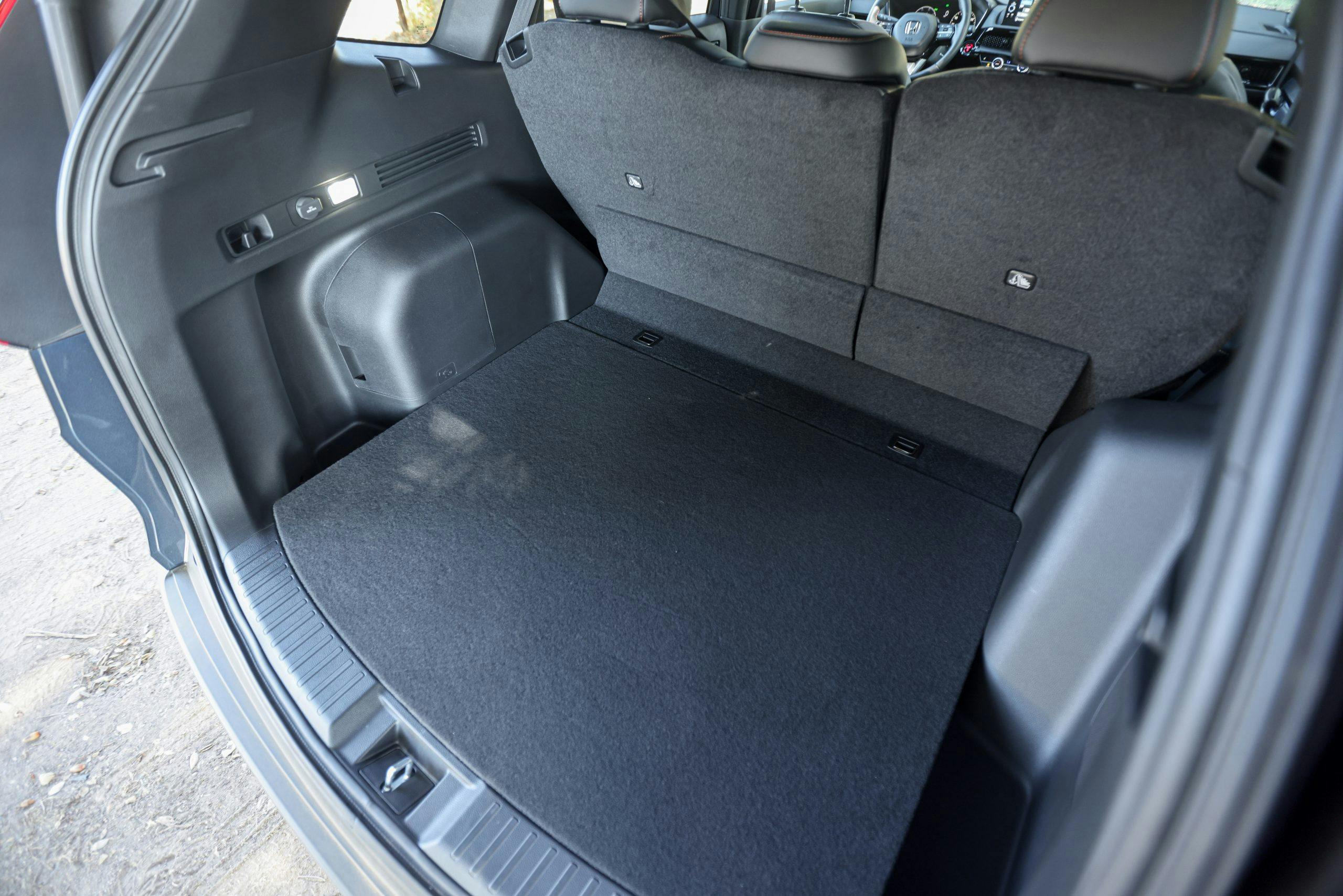First Look Review: 2023 CR-V gives Honda fans no reason to shop elsewhere
Honda’s sixth-generation CR-V has some big shoes to fill. Since it was first launched in 1997, the compact crossover was Honda’s number-one-selling model in the United States. Since 2017, it has been the best-selling Honda in the world. It’s fair to say that the 2023 model introduces Honda’s most important CR-V generation yet, especially considering it’s going up against heavyweights such as the Toyota RAV4 and newcomers like Mazda’s athletic CX-50.
To see how the new CR-V improves over its predecessor, Honda invited us to drive the 2023 CR-V in and around Santa Barbara, California. The vehicle we spent most of our time with was a well-equipped, Sport Touring model. For 2023, EX and EX-L trim levels will be powered by a 1.5-liter turbocharged four-cylinder that produces 190 hp and 179 lb-ft of torque. Their MSRPs start at $32,355 and $35,004, respectively. Sport and Sport Touring models will use a hybrid powertrain that pairs a naturally aspirated, 2.0-liter four-cylinder with a pair of electric motors for a total of 204 hp. Their MSRPs start at $33,695 and $39,845.
Notably absent is an LX trim. Honda has been selling everything it can build and half of its vehicles are sold before they hit the dealership lots. As such, the budget-friendly LX has been put on hiatus for now. It was planned, and Honda knows what it will include and omit to make this frugal offering hit the right price point, but it’s not in the works for 2023.

2023 Honda CR-V Sport Touring
- Price: $39,845/ TBD (base / as-tested)
- Powertrain: 2.0-liter, naturally aspirated I-4; two-motor hybrid
- Output: 204 hp combined, 247 lb-ft 0-2000 rpm
- Layout: Four-door, front-engine, five-passenger, FWD or AWD unibody crossover
- EPA fuel economy: 40 city/35 mpg highway, 37 mpg combined
- Rivals: Toyota RAV-4, Mazda CX-5, Mazda CX-50, Hyundai Tucson, Ford Escape, Chevrolet Equinox, Subaru Forester
From the outside, the 2023 CR-V looks like an all-new vehicle. Underneath, it’s almost completely redesigned as well. It stretches 2.7 inches longer overall and its wheelbase is 1.6 inches longer thanks to a new rear floor module with reinforced rear spring and trailing arm mounts. Nearly everything in front of the firewall is new, including the chassis rails and an aluminum subframe that is lighter and 15 percent more rigid than before. The 2023 model is also slightly wider, with both front and rear tracks widened by 0.4 inches as a result of new subframe assemblies.

On paper, the hybrid drivetrain seems very similar to the one found in the outgoing CR-V, and it is. However, this updated powertrain is more efficient and more powerful. While it adds just three total horsepower over the previous-generation system, it flattens the torque curve of the combined output, churning out an additional 15 lb-ft of torque from 0 to 2000 rpm compared to the outgoing two-motor hybrid system. It’s also able to send half of the system’s power to the rear wheels for a true 50:50 split in power, compared to the 2022 CR-V’s 60:40. The 2023 hybrid powertrain changes also allow the engine to directly power the wheels under a wider range of circumstances. There’s still no traditional transmission or CVT in the Hybrid drivetrain, instead, two motors take up that role and act to power the car, absorbing the difference between engine speed and wheel speed, while also generating power to keep the 1.1-kWh lithium-ion battery charged.
The improvement in the hybrid drivetrain is apparent behind the wheel, where throttle response is smooth and acceleration is linear. The electric motor boosts low-end performance and the CR-V feels, appropriately, almost like an electric car. Mamadou Diallo, Honda’s vice president of auto sales, gave us the rundown on the CR-V’s sales success and told us that Honda expects 50 percent of CR-V models to be hybrid. Honda hopes that these hybrid models will serve as a stepping stone, and that many 2023 CR-V buyers will move to an EV for their next purchase. To bridge the gap, the hybrid models use Braking Mode, found on the shift pattern after Drive, which is almost a one-pedal driving mode. The vehicle will still creep when using Braking mode, so it’s not totally like an EV, but regenerative braking is increased. Even in Drive, extra brake regen can be employed by using paddles mounted behind the spokes of the steering wheel. We found them useful when coasting down long, steep grades.

The ride is compliant enough to soak up imperfections in the road and firm enough to keep the crossover from wallowing through windy roads. Honda aimed for this to be the most fun-to-drive CR-V yet and did a great job of planning a route that showed that a compact crossover can grip the road without tossing around its occupants. On the highway, Honda’s multiple tweaks to NVH have resulted in a very quiet ride with little powertrain noise. We briefly watched the powerflow chart in the center screen that charted the charging and discharging of the batter and, as expected, the transition between all modes was totally seamless. The EPA rating for the all-wheel-drive hybrid powertrain like the one we were driving is an impressive 40 mpg city, 34 highway, and 37 combined. We didn’t fill up to check, but the driver information told us that even at a brisk highway pace keeping up with traffic returned mileage in the high 30s. For those wanting even more efficiency, a FWD version will increase those miles-per-gallon numbers to 43/36/40.
The front seats provide a nice amount of bolstering without being confining and offer an impressive range of adjustability. At six feet, three inches tall, our tallest driver (and your author) found that, unlike a lot of compact vehicles, the seat did not need to be moved all the way aft to provide sufficient legroom. The 2023 CR-V had more than enough seat travel to accommodate. There was also a journalist in attendance who was a few inches taller and he was also impressed by the roominess. Likewise, ample headroom in the front, even with the standard sunroof, allowed for the seat to be moved up high enough that the door sill could serve as a comfortable armrest.

Rear seats are equally comfortable and offer an abundance of legroom, even when adjusted to the rear of their travel to fit a tall driver. Accommodations in the back row are roomy and comfortable, if not quite as plush as up front. There’s just less soft-touch trim to be found as the door panels are finished in kid- and pet-friendly plastic rather than matching upholstery. Speaking of kid-friendly, Honda designed the second-row seats to swing wide open, nearly 90 degrees, to allow for plenty of room when securing and removing a child safety seat.
There are at least 10 steps of adjustability in reclining the rear seats, but the bolt-upright setting is really meant for providing a vertical front bulkhead for cargo. The adjustment is made using the same mechanism used to fold the seats flat: levers at the top outboard corners of the seats. Reclining while seated is a bit awkward—not only is the lever in a shoulder-wrenching place, but any rearward pressure may cause the seat to suddenly assume the most reclined position.
In our brief time with the CR-V we were pleasantly surprised by just how well larger passengers fit in the vehicle; the aforementioned rear seat adjustment was our only real gripe. The hybrid powertrain on the CR-V Sport will likely be a huge seller, as it offers both better performance and increased fuel economy.
Turbo-powered 2023 Honda CR-V models are currently on sale, with Hybrid deliveries coming shortly.
2023 Honda CR-V Sport Touring
Price: $39,845/ TBD (base / as-tested)
Highs: Well-thought-out packaging, taught but forgiving suspension, assertive exterior design.
Lows: Rear seat recline is awkward. Value seekers will have to wait for an LX trim to be offered.
Takeaway: Roomier, more efficient, and more powerful than its predecessor, the 2023 model gives current CR-V customers no reason to shop elsewhere.






Three words = four words: Continuously Variable Transmission = No Way For Me.
CVT, . . . NEVER
CVT, road noise. Had a 2019 and did not keep it long. Great gas mileage though.
Hopefully the noise issue has been addressed.
I can’t stand Honda CVT’s. Also why no performance Spec with the turbo 4?
The hybrid drivetrain doesn’t use a CVT.
Have a 2013 Accord with crv. Smooth and no issues.
I’ve always said never to a cvt also but I think that they will become more prevelant. Just like we can no longer say that we will never own a bev car. I don’t say never anymore. I like the looks of this CR-V better then the old one, I’m sure it will sell well.
I just traded in my 2018 for the 2023 and it’s a massive disappointment in a few ways. Most notably the driver’s seat is incredibly uncomfortable. I can barely stand driving the car because my butt is sore after like 2 minutes. Everything about the car feels larger than on the 2018– why on earth did they make the driver’s seat smaller? The car is super sluggish both from a standstill and also when accelerating on the highway. It’s also hard to maneuver in small spaces– what would have been a one point turn on the 2018 is a 3 point turn in the 2023.
Loving our ‘19 RDX while Honda figures out the hydrogen direction. Use a photovoltaic roof to split water into hydrogen. “ Better stop to fill up………..with water!”